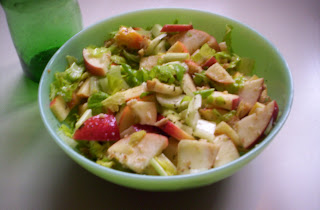Yes, I take my veggie prep very seriously, madam!
Always read through the whole recipe before you begin.

Ingredients
- 1 big bunch of chard (white will work, but red or rainbow is the prettiest; if the bunches are smallish, get two for good measure)
- 2-3 cloves of garlic (don’t worry, it won’t be too garlicky)
- 1 medium onion
- 3 Tbs. olive oil (approximately; enough to coat the bottom of the frying pan, in any case; a bit more if you like olive oily goodness)
- 1 lemon
- 2-3 ripe tomatoes (I know you love them now!)
- plenty of shredded Parmesan cheese (mmmmmmmm)
- 1 box penne pasta (that’s 1 lb.; you can use other shapes, of course, but this one seems to work the nicest)
- salt (oh, yeah; don’t forget the salt)
Directions
- Set the water to boil as you prepare all the veggies, but don’t add the pasta until you start sautéing the the veggies. Follow the directions on the box. Make sure to use lots of water, or the pasta sticks to itself.
- Tomatoes: chop into “large dice” (i.e. smaller than you would make them for a salad, but a bit bigger than they would be in salsa).
- Lemon: cut into wedges.
- Cheese: shred with the smaller of the two standard sizes on a grater; about 2 cups worth should do. (More if you’re a typical Wisconsin family, of course.)
- Chard: make sure to rinse it very well in cold water (sometimes there’s a little dirt or grit left on leafy veggies like chard). Trim off just the very end of the stems. Then separate the stems from the leafy part. (Just run the knife down either side of the stem. You don’t have to be too exact here. In fact, you can just skip the step altogether and simply chop the chard whole. I just like separating the stems, though so I can cook them longer than the leaves. It makes everything a more consistent texture.) Chop the stems into ¼ - or ½ - inch pieces. Set them aside. Stack up all the leaves and give it a couple of cuts through them all with a knife. You can leave the leaves in pretty big pieces, because they really shrink down when they cook.
- Garlic: take the papery stuff off by trimming the end and peeling. Place on a cutting board, put the flat side of a wide knife on top, and give ‘em a good hard whack. Garlic will be smashed but basically in one piece still. Fun.
- Onion: chop into dice (a bit smaller than those tomato chunks, but big enough that they won’t simply dissolve when you cook them). Do this last if onions make you cry. (You big crybaby!)
- Heat the olive oil in a big, heavy sauté or fry pan over a medium high heat. Give it a few minutes to get to it’s full temperature, and then toss in the cloves of garlic. You’re just going to flavor the oil, so let them go until they are nice and golden brown on one side, then kind of flip them over and brown the other side, too. (Medium high heat should be hot enough that the cloves of garlic sizzle immediately but that they don’t start scorching right away.) Take the cloves out and toss them away before they get too dark. (Dark garlic gets a bitter taste.)
- Put the pasta in the fully boiling water now. It will probably take about 10-12 minutes or so to cook, and that’s plenty of time for the veggies.
- Add the onion. Flip them around occasionally with a spatula. Let them get translucent (shiny and a bit see-through). Just as they are starting to brown a bit around the edges, then...
- Add the stem pieces. Cook them for about as long as you cooked the onion. Test a little piece with a fork. If it’s pretty tender to bite into, then...
- Add the leafy bits. You’re going to start stirring this in careful, because the uncooked leaves like to jump out of the pan about now. As you stir and flip all the ingredients together in the pan, you’ll be surprised at how quickly they start to cook down. It’s at this stage that you want to add salt. One always salts “to taste,” but you might start with about 1 tsp.
- Once you’ve stirred and tossed enough to evenly distribute the salt, and once the leafy parts are all nice and limp, give it a taste. Check to see if the salt level is where you want it. Check to see if the leaves and stems are both nice and tender. (You don’t want any significant crunch left in a cooked green leafy vegetable.) Then you are done. Turn off the heat and wait for the pasta to be done.
- When the pasta is done, drain it and then just put it right into the frying pan with the chard (or back in the empty pasta pot if there’s not enough room; I like putting it in with the chard because when pasta is first out of the water it’s still “thirsty” and like so soak in liquids and flavors, like all the good stuff in the pan). Mix the chard and pasta together and put in serving bowl.
- Everyone can add the tomato and cheese on their own plate and squeeze the lemon juice on their own. (I think the lemon is really key to bringing these ingredients all together. It’s amazing how many dishes need that little hint of acid for all the flavors to come out.)
- Sweet boots! It’s time to eat.














